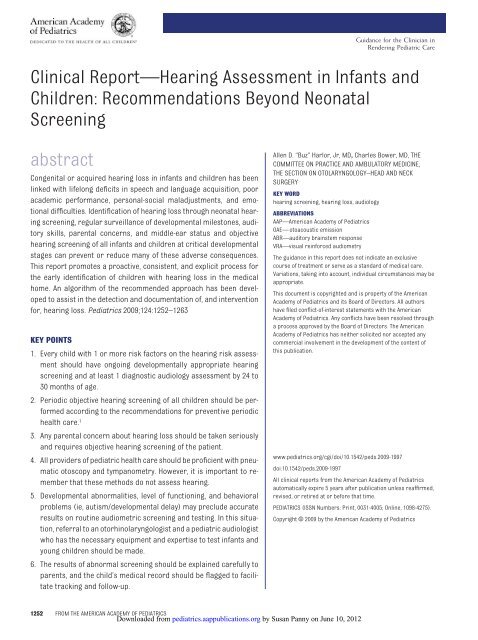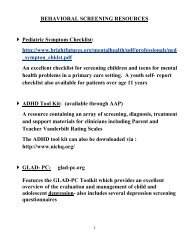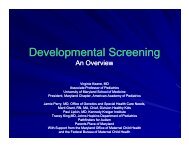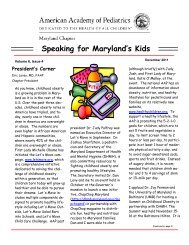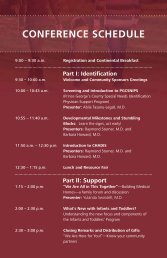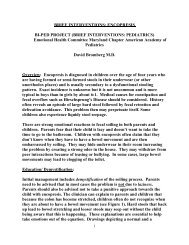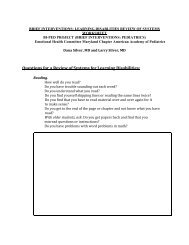Guidance for the Clinician inRendering Pediatric CareClinical Report—<strong>Hearing</strong> <strong>Assessment</strong> in Infants <strong>and</strong>Children: <strong>Recommendations</strong> Beyond NeonatalScreeningabstractCongenital or acquired hearing loss in infants <strong>and</strong> children has beenlinked with lifelong deficits in speech <strong>and</strong> language acquisition, pooracademic performance, personal-social maladjustments, <strong>and</strong> emotionaldifficulties. Identification of hearing loss through neonatal hearingscreening, regular surveillance of developmental milestones, auditoryskills, parental concerns, <strong>and</strong> middle-ear status <strong>and</strong> objectivehearing screening of all infants <strong>and</strong> children at critical developmentalstages can prevent or reduce many of these adverse consequences.This report promotes a proactive, consistent, <strong>and</strong> explicit process forthe early identification of children with hearing loss in the medicalhome. An algorithm of the recommended approach has been developedto assist in the detection <strong>and</strong> documentation of, <strong>and</strong> interventionfor, hearing loss. Pediatrics 2009;124:1252–1263KEY POINTS1. Every child with 1 or more risk factors on the hearing risk assessmentshould have ongoing developmentally appropriate hearingscreening <strong>and</strong> at least 1 diagnostic audiology assessment by 24 to30 months of age.2. Periodic objective hearing screening of all children should be performedaccording to the recommendations for preventive periodichealth care. 13. Any parental concern about hearing loss should be taken seriously<strong>and</strong> requires objective hearing screening of the patient.4. All providers of pediatric health care should be proficient with pneumaticotoscopy <strong>and</strong> tympanometry. However, it is important to rememberthat these methods do not assess hearing.5. Developmental abnormalities, level of functioning, <strong>and</strong> behavioralproblems (ie, autism/developmental delay) may preclude accurateresults on routine audiometric screening <strong>and</strong> testing. In this situation,referral to an otorhinolaryngologist <strong>and</strong> a pediatric audiologistwho has the necessary equipment <strong>and</strong> expertise to test infants <strong>and</strong>young children should be made.6. The results of abnormal screening should be explained carefully toparents, <strong>and</strong> the child’s medical record should be flagged to facilitatetracking <strong>and</strong> follow-up.Allen D. “Buz” Harlor, Jr, MD, Charles Bower, MD, THECOMMITTEE ON PRACTICE AND AMBULATORY MEDICINE,THE SECTION ON OTOLARYNGOLOGY–HEAD AND NECKSURGERYKEY WORDhearing screening, hearing loss, audiologyABBREVIATIONS<strong>AAP</strong>—American Academy of PediatricsOAE—otoacoustic emissionABR—auditory brainstem responseVRA—visual reinforced audiometryThe guidance in this report does not indicate an exclusivecourse of treatment or serve as a st<strong>and</strong>ard of medical care.Variations, taking into account, individual circumstances may beappropriate.This document is copyrighted <strong>and</strong> is property of the AmericanAcademy of Pediatrics <strong>and</strong> its Board of Directors. All authorshave filed conflict-of-interest statements with the AmericanAcademy of Pediatrics. Any conflicts have been resolved througha process approved by the Board of Directors. The AmericanAcademy of Pediatrics has neither solicited nor accepted anycommercial involvement in the development of the content ofthis publication.www.pediatrics.org/cgi/doi/10.1542/peds.2009-1997doi:10.1542/peds.2009-1997All clinical reports from the American Academy of Pediatricsautomatically expire 5 years after publication unless reaffirmed,revised, or retired at or before that time.PEDIATRICS (ISSN Numbers: Print, 0031-4005; Online, 1098-4275).Copyright © 2009 by the American Academy of Pediatrics1252 FROM THE AMERICAN ACADEMY OF PEDIATRICSDownloaded from pediatrics.aappublications.org by Susan Panny on June 10, 2012
FROM THE AMERICAN ACADEMY OF PEDIATRICS7. Any abnormal objective screeningresult requires audiology referral<strong>and</strong> definitive testing.8. A failed infant hearing screening ora failed screening in an older childshould always be confirmed by furthertesting.9. Abnormal hearing test results requireintervention <strong>and</strong> clinicallyappropriate referral, including otolaryngology,audiology, speechlanguagepathology, genetics, <strong>and</strong>early intervention.INTRODUCTIONFailure to detect congenital or acquiredhearing loss in children may resultin lifelong deficits in speech <strong>and</strong>language acquisition, poor academicperformance, personal-social maladjustments,<strong>and</strong> emotional difficulties.Early identification of hearing loss <strong>and</strong>appropriate intervention within thefirst 6 months of life have been demonstratedto ameliorate many of theseadverse consequences <strong>and</strong> facilitatelanguage acquisition. 2 Supportive evidenceis outlined in the Joint Committeeon Infant <strong>Hearing</strong>’s “Year 2007Position Statement: Principles <strong>and</strong>Guidelines for Early <strong>Hearing</strong> Detection<strong>and</strong> Intervention Programs,” whichwas endorsed by the American Academyof Pediatrics (<strong>AAP</strong>). 3 This evidencealso is part of the rationale for the <strong>AAP</strong>statement “Newborn <strong>and</strong> Infant <strong>Hearing</strong>Loss: Detection <strong>and</strong> Intervention,” 4which endorses universal hearingscreening <strong>and</strong> reviews the primary objectives,important components, <strong>and</strong>recommended screening methods <strong>and</strong>parameters that characterize an effectiveuniversal hearing screeningprogram. Furthermore, the <strong>AAP</strong>statement “<strong>Recommendations</strong> forPreventive Pediatric Health Care” 1promotes objective newborn hearingscreening as well as periodic hearingscreening for every child throughadolescence (Table 1).TABLE 1 <strong>Recommendations</strong> for PreventivePediatric Health Care 1Stage Age SensoryScreening:6. <strong>Hearing</strong>InfancyPrenatalNewborna3–5 d 1 bBy1mob2mob4mob6mob9mobEarly childhood 12 mob15 mob18 mob24 mob30 mob3yb4yaMiddle childhood 5 ya6ya7yb8ya9yb10 yaAdolescence 11 yb12 yb13 yb14 yb15 yb16 yb17 yb18 yb19 yb20 yb21 ybaTo be performed.bRisk assessment, with appropriate action to follow ifpositive.All providers of pediatric health careneed to recognize children who are atrisk of or who suffer from congenital oracquired hearing loss, be prepared toscreen their hearing, <strong>and</strong> assist the family<strong>and</strong> arrange for proper referral <strong>and</strong>treatment by identifying available hearingresources within their communities.In addition, the pediatric health care professionalcan play an important role incommunication with the child’s schoolteacher<strong>and</strong>/or nurse <strong>and</strong> special educationprofessionals to facilitate proper accommodation<strong>and</strong> education once ahearing deficit has been confirmed.This clinical report replaces the previous2003 clinical report <strong>and</strong> seeks topromote a proactive, consistent, <strong>and</strong>explicit process for the early identificationof children with hearing loss inthe medical home. To assist in the detection<strong>and</strong> documentation of <strong>and</strong> interventionfor hearing loss, an algorithmof the recommended approachwith key points has been developed(Fig 1), as have several tables.RISK INDICATORS FOR HEARINGLOSSSome degree of hearing loss (Table 2)is present in 1 to 6 per 1000 newborninfants. 5 Most children with congenitalhearing loss are potentially identifiableby newborn <strong>and</strong> infant hearingscreening. However, some congenitalhearing loss may not become evidentuntil later in childhood. <strong>Hearing</strong> lossalso can be acquired during infancy orchildhood for various reasons. Infectiousdiseases, especially meningitis,are a leading cause of acquired hearingloss. Trauma to the nervous system,damaging noise levels, <strong>and</strong> ototoxicdrugs can all place a child at riskof developing acquired hearing loss. 6,7Otitis media is a common cause of usuallyreversible hearing loss. Certainphysical findings, historical events,<strong>and</strong> developmental conditions may indicatea potential hearing problem.These conditions include, but are notlimited to, anomalies of the ear <strong>and</strong>other craniofacial structures, significantperinatal events, <strong>and</strong> global developmentalor speech-language delays.All older infants <strong>and</strong> children should bescreened for risk factors involving hearingproblems. A summary of high-risk indicatorsfor hearing loss <strong>and</strong> developmentalmilestones are included inTables 3 <strong>and</strong> 4, respectively. All infantswith a risk indicator for hearing loss, regardlessof surveillance findings, shouldbe referred for an audiologic assessmentat least once by 24 to 30 months ofage, even if the child passed the newbornhearing screening. Children with risk indicatorsthat are highly associated withdelayed-onset hearing loss, such as hav-PEDIATRICS Volume 124, Number 4, October 2009 1253Downloaded from pediatrics.aappublications.org by Susan Panny on June 10, 2012


